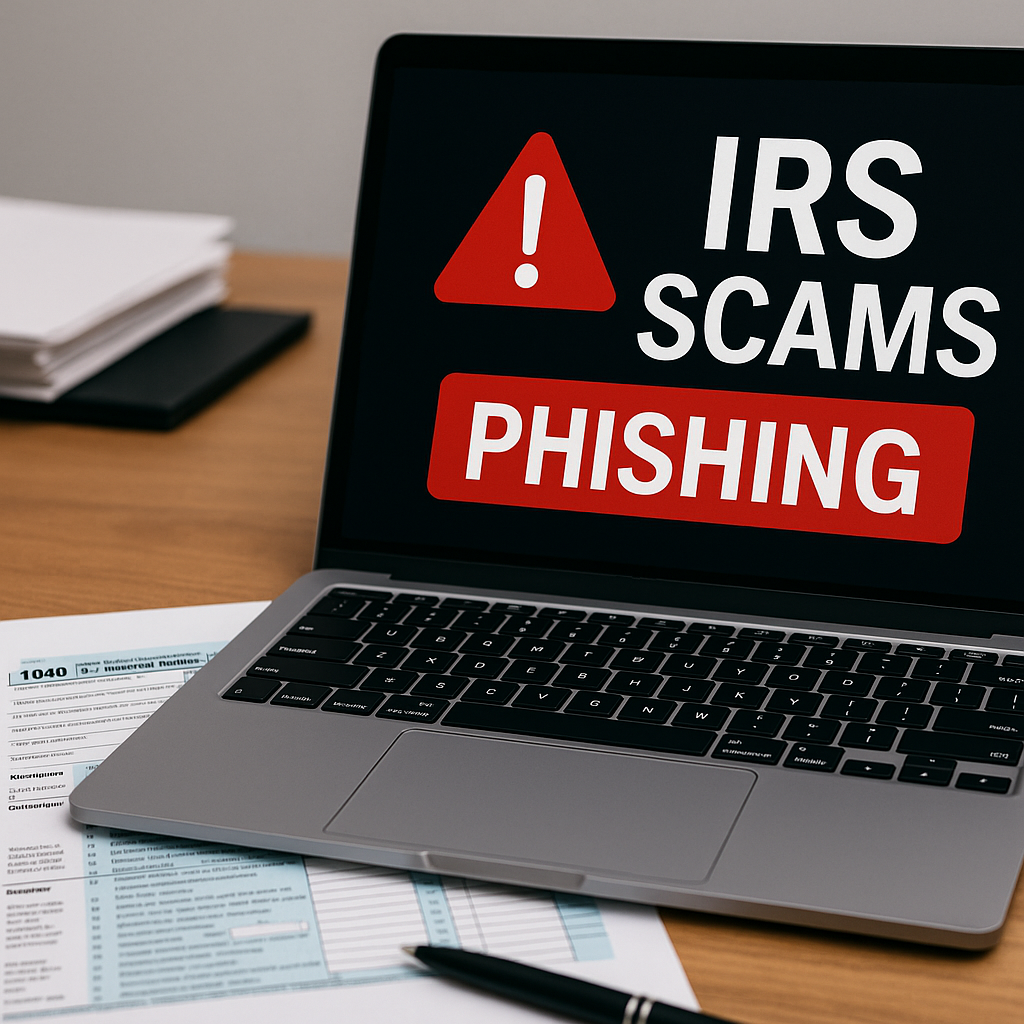
Table of Contents
When tax season rolls around in the U.S., cybercriminals come out in full force. IRS scams and tax-time phishing attacks have become increasingly sophisticated in 2025, targeting freelancers, small business owners, and everyday taxpayers. If you’re filing online, using an accountant, or even just checking your email—you’re a potential target.
In this post, we’ll break down how these tax scams in 2025 work, the red flags to look out for, and actionable ways to protect your data before, during, and after tax season.
Common Types of IRS Scams:
- Fake tax refund emails asking you to “claim your refund”
- Phone calls from someone pretending to be an IRS agent threatening legal action
- Text messages with malicious links disguised as IRS alerts
- Fraudulent websites imitating the IRS e-File system
In 2025, scammers are using AI-generated messages that look and sound official. They mimic IRS language, logos, and even use spoofed email addresses to appear credible.
Tax-Time Phishing Attacks Are Evolving
Tax-time phishing is a specific type of cyberattack where criminals send emails or texts designed to trick you into giving up sensitive data—like your Social Security number, login credentials, or bank info.
New Tactics in 2025:
- AI-generated tax forms with hidden malware
- Personalized messages using data leaks (e.g., “Your 2023 return is incomplete”)
- Phishing emails targeting CPAs and bookkeepers to access client information
Cybersecurity experts report a 37% rise in tax-related phishing attempts in 2025 alone. If you’re a freelancer or business owner managing your own taxes, your risk is even higher.
Signs You’re Dealing with a Tax Scam
Understanding the red flags is the first step to protect your data from IRS scams. Here are a few things to look out for:
- Urgent language like “immediate payment required” or “your return is under audit”
- Unusual payment requests like gift cards or cryptocurrency
- Hyperlinks that don’t match official IRS domains (always check for
.gov) - Attachments in unexpected emails (especially PDF or .exe files)
Remember: The IRS never contacts taxpayers via email, text, or social media to request personal or financial information.
How to Protect Your Data from IRS Scams in 2025
Now let’s talk about prevention. Here are proactive steps you can take to avoid falling victim to tax-time phishing and IRS fraud in 2025.
1. Use a Secure Tax Filing Service
Choose a trusted tax filing platform that offers two-factor authentication and encrypted data storage. Look for services with positive reviews and official IRS authorization.
Tip: Avoid clicking tax links sent via email. Instead, go directly to the service’s official website.
2. Protect Your Email
Many IRS scams start with a compromised email account. Use a secure email service like Proton Mail or enable encryption and spam filters on your existing one.
3. Install Anti-Phishing Tools
Add browser extensions like uBlock Origin, Privacy Badger, or Avast Online Security to block suspicious links and known phishing domains.
4. Keep Software Updated
Ensure your operating system, antivirus, and browser are up to date. Many tax-time phishing campaigns exploit outdated software vulnerabilities.
5. Monitor Your Credit
Sign up for a free credit monitoring service (like Credit Karma or Experian). IRS scammers often use stolen identities to open credit accounts or apply for fraudulent refunds.
For Freelancers & Small Businesses: You’re a Prime Target
For Freelancers & Small Businesses: You’re a Prime Target
If you run a business or freelance on platforms like Upwork or Fiverr, you’re an especially lucrative target. Scammers often:
- Target accounting tools like QuickBooks or FreshBooks with fake invoices
- Send phishing emails posing as “IRS reminders for 1099 contractors”
- Attempt to hack cloud storage with tax documents (e.g., Google Drive or Dropbox)
Best Practices:
- Store tax documents in encrypted folders
- Don’t open tax-related attachments unless verified
- Use a VPN when accessing financial data remotely
What to Do If You Suspect a Scam
If you believe you’ve encountered an IRS scam or tax-time phishing message:
- Don’t respond or click links – delete the message immediately.
- Forward phishing emails to phishing@irs.gov.
- Report identity theft at identitytheft.gov.
- Change all related passwords and enable multi-factor authentication.
- Alert your CPA or tax preparer so they can take additional precautions.
Final Thoughts: Protect Your Data Before It’s Too Late
IRS scams and tax-time phishing in 2025 are more convincing and dangerous than ever. Whether you’re an individual taxpayer, a remote worker, or a business owner, the risks are real—but so are the defenses.
By staying informed and taking a few smart precautions, you can protect your data, avoid identity theft, and file your taxes with confidence.
✅ Take Action Now: Don’t Wait Until It’s Too Late
Before your W-2 or 1099 even arrives, take 10 minutes to:
- Update your passwords
- Set up 2FA on your email
- Run a quick security audit using tools like Have I Been Pwned
- Bookmark the official IRS website for safe access
Want more tips on avoiding digital scams in 2025? Subscribe to our newsletter for weekly cybersecurity updates built for freelancers, solopreneurs, and small business owners.
Also Read :Why Secure File Sharing Tools for Freelancers and Clients Matter in 2025

Pingback: best password managers for freelancers 2025